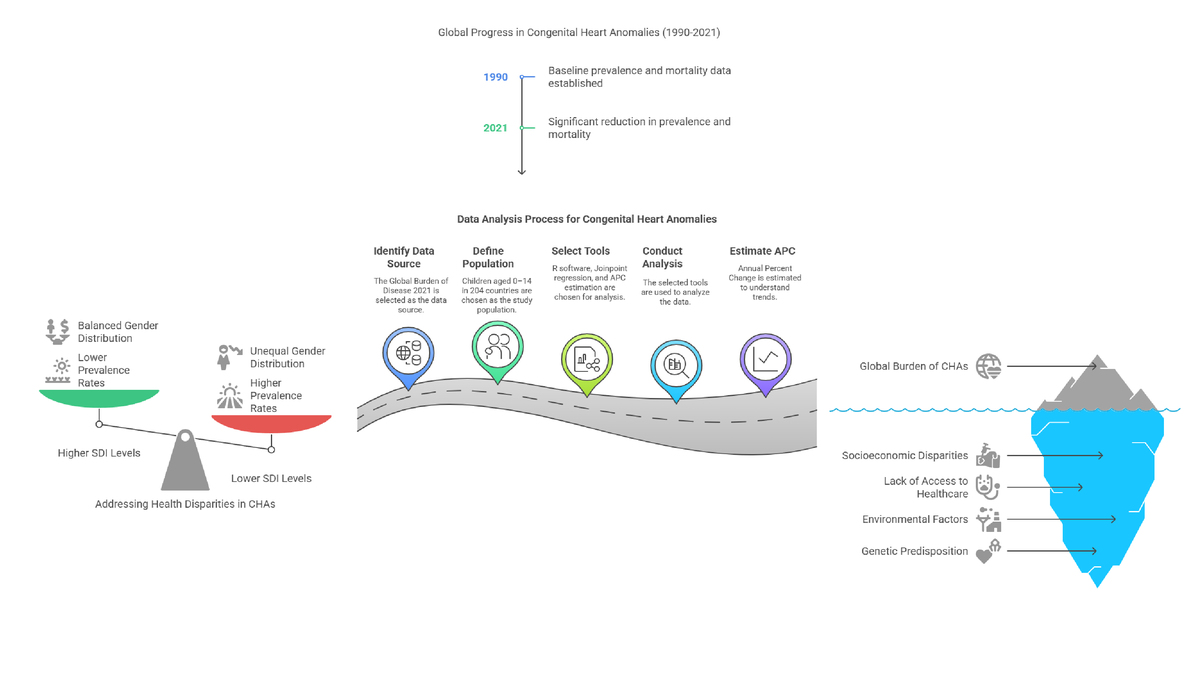Current issue
Archive
Manuscripts accepted
About the Journal
Editorial office
Editorial board
Section Editors
Abstracting and indexing
Subscription
Contact
Ethical standards and procedures
Most read articles
Instructions for authors
Article Processing Charge (APC)
Regulations of paying article processing charge (APC)
CARDIOLOGY / RESEARCH PAPER
Evolving Global Patterns of Congenital Heart Anomalies from 1990 to 2021
1
Wenzhou People's Hospital, China
2
Pingyang Hospital of Wenzhou Medical University, China
3
Wenzhou Yebo Proctology Hospital, China
These authors had equal contribution to this work
Submission date: 2025-02-26
Final revision date: 2025-05-02
Acceptance date: 2025-05-18
Online publication date: 2025-06-23
KEYWORDS
TOPICS
ABSTRACT
Introduction:
Background Congenital heart anomalies (CHAs) remain a significant global health issue for children, evidenced by persistent disparities in healthcare access across different socio-demographic index (SDI) regions and genders, despite slight decreases in prevalence.
Material and methods:
This cross-sectional study used the Global Burden of Disease 2021 dataset to analyze CHAs in children aged 0-14 from 204 countries. Data analysis was performed using R software, incorporating global mapping, Joinpoint regression, and estimation of annual percent changes and rates, stratified by age, sex, and SDI.
Results:
A total of 218,909,652 children (113,892,505 males [52.03%]; 105,017,147 females [47.97%]) were included in the analysis. From 1990 to 2021, the global prevalence of CHAs in children decreased by 4.294%(95% uncertainty interval [UI], -5.696%––2.695%). Over three decades, CHA-associated deaths decreased from 497,979 (95% UI, 282,166–642,052) to 222,415 (95% UI, 181,359–275,182). The global mortality rate decreased from 28.633 (95% UI, 16.224-36.918) to 11.055 (95% UI, 9.014-13.678) per 100,000 population, while the prevalence rate changed from 377.257 cases per 100,000 in 1990 to 361.060 cases per 100,000 in 2021. Among the five SDI regions, the low SDI region had the highest CHA-associated mortality rate in 2021.
Conclusions:
The study highlights the persistent global challenge of CHAs, particularly in low-SDI regions. It underscores the need for targeted public health interventions to reduce disparities and improve health outcomes globally.
Background Congenital heart anomalies (CHAs) remain a significant global health issue for children, evidenced by persistent disparities in healthcare access across different socio-demographic index (SDI) regions and genders, despite slight decreases in prevalence.
Material and methods:
This cross-sectional study used the Global Burden of Disease 2021 dataset to analyze CHAs in children aged 0-14 from 204 countries. Data analysis was performed using R software, incorporating global mapping, Joinpoint regression, and estimation of annual percent changes and rates, stratified by age, sex, and SDI.
Results:
A total of 218,909,652 children (113,892,505 males [52.03%]; 105,017,147 females [47.97%]) were included in the analysis. From 1990 to 2021, the global prevalence of CHAs in children decreased by 4.294%(95% uncertainty interval [UI], -5.696%––2.695%). Over three decades, CHA-associated deaths decreased from 497,979 (95% UI, 282,166–642,052) to 222,415 (95% UI, 181,359–275,182). The global mortality rate decreased from 28.633 (95% UI, 16.224-36.918) to 11.055 (95% UI, 9.014-13.678) per 100,000 population, while the prevalence rate changed from 377.257 cases per 100,000 in 1990 to 361.060 cases per 100,000 in 2021. Among the five SDI regions, the low SDI region had the highest CHA-associated mortality rate in 2021.
Conclusions:
The study highlights the persistent global challenge of CHAs, particularly in low-SDI regions. It underscores the need for targeted public health interventions to reduce disparities and improve health outcomes globally.
We process personal data collected when visiting the website. The function of obtaining information about users and their behavior is carried out by voluntarily entered information in forms and saving cookies in end devices. Data, including cookies, are used to provide services, improve the user experience and to analyze the traffic in accordance with the Privacy policy. Data are also collected and processed by Google Analytics tool (more).
You can change cookies settings in your browser. Restricted use of cookies in the browser configuration may affect some functionalities of the website.
You can change cookies settings in your browser. Restricted use of cookies in the browser configuration may affect some functionalities of the website.



